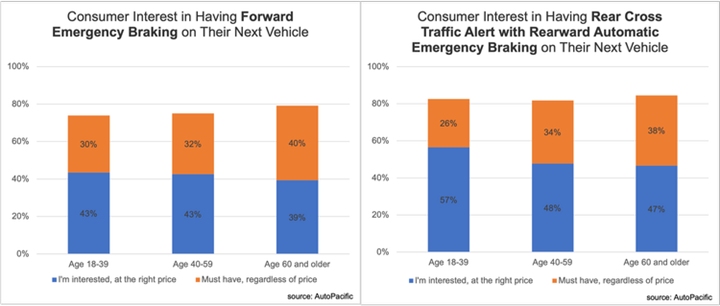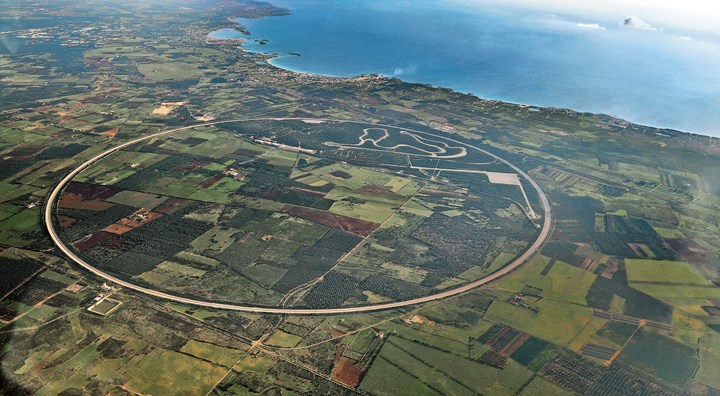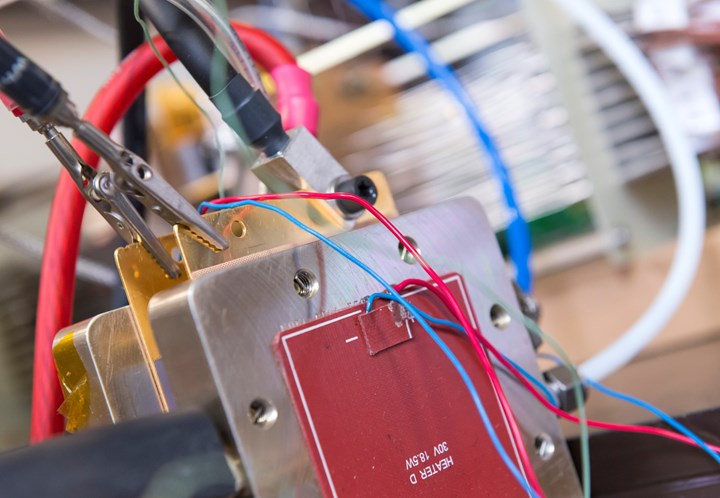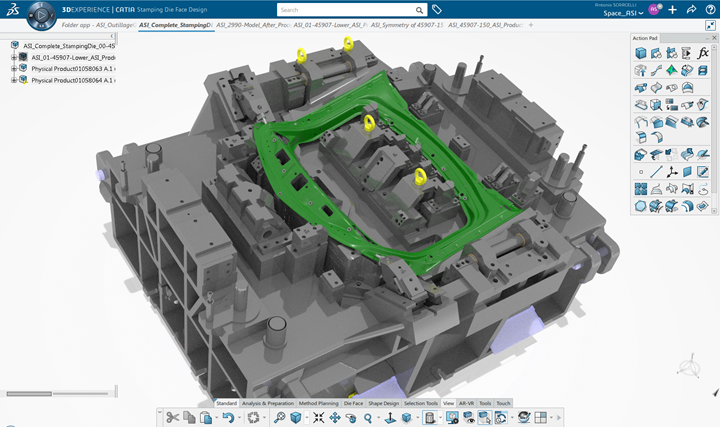on the Ford F-150 Lightning, Safety, Porsche Testing, Fuel Cell Material Switch, Mazda CX-50 & More
Ford goes full-size (as in pickups) in EVs. . .AutoPacific shows seniors like safety tech. . .Porsche test track in Italy. . .iron may make fuel cells accessible. . .bike sharing algorithm. . .BMW & CAD. . .Mazda CX-50 review
#regulations
Struck By Ford Lightning

Note the grille, the wrap-around lighting and the charge port on the fender. These are key visual differences of the F-150 Lightning, shown here in Platinum trim. As for the part of the truck you can’t see: Looks just like new F-150.(Image: Ford)
This is actually quite clever.
Ford has had the F Series pickup in the leading sales spot for 45 years. There have been on the order of 40 million units sold in the truck’s history. There are some 17-million F-Series trucks on the road, or about 6% of all the passenger vehicles rolling in America.
It has the familiarity of a can of Coke or an iPhone. (As of 2019, according to the Boston Consulting Group, the F-Series generated more revenue ($42-billion) than Coca-Cola ($37-billion) but less than the iPhone ($55-billion).)
Ford is taking its transformation to electrification so seriously that it has split the company into Ford Blue, for its ICE offerings, and Ford Model e, for electric. There is also Ford Pro, which focuses on the company’s commercial business.
For its first passenger vehicle offering it developed the Mustang Mach-E, which is based on a new platform.
For Ford Pro, it transformed its Transit by adding an electric powertrain.
To vastly increase the bandwidth for electric vehicles, it has essentially taken the existing F-150 and have created Lightning, the electric F-150.
Essentially, Not entirely.
What It’s Like
To drive a Lightning is simply like driving an F-150. There are some differences, though. Like the improved responsiveness when the accelerator is depressed. Like the perceptible absence of sound. Like a smooth ride (there is an independent rear suspension; there is no step-gear transmission).
And that’s pretty much what Ford intended. A truck that is familiar to millions that has been electrified: Get in and drive.
What’s more, it meets the expectations of those who use a truck as a truck, which means it can tow— a maximum10,000 pounds--and it can haul—a payload capacity of 2,235 pounds. (The electric powertrain makes either task transparent.)
A Difference
But this isn’t merely an F-150 with its engine and transmission removed and replaced.
For one thing, in order to provide the towing and hauling capabilities while also accommodating the lithium-ion batteries (standard is a 98-kWh battery that is good for an estimated range of 230 miles; the extended range battery provides 131-kWh and an estimated 320-mile range), a new high-steel frame was developed for the Lightning: it is not a frame used for other Ford trucks.
Consider: an ICE F-150 weighs on the order of from 5,540 to 5,740 pounds.
An F-150 Lightning goes from 6,171 to 6,590 pounds.
That’s why they need a new frame.
All Lightnings—wither they have the standard- or extended-range battery (battery production is at the Ford Rawsonville Components Plant)—have two three-phase fixed magnet AC motors (built at the Ford Van Dyke Transmission Plant), so with one on the front axle and one on the rear, every truck is AWD. The horsepower for the standard battery truck is 452; the horsepower for the extended-range battery is 580 hp. Both versions provide 775 lb-ft of torque.
From a styling point of view, it has some exterior modifications, particularly in the front, which provide a more advanced-tech appearance while helping, according to chief program engineer Linda Zhang, improve the overall aero of the vehicle. While the exterior sheet metal is different from the gas-powered version, you’d have to be an F-150 aficionado to notice.
No one will mistake this for being anything but an F-150.
Cargo
What’s under the hood—yes, there is a hood—isn’t one of the two motors (arguably the front motor is in there but it isn’t visible), but a storage compartment, or “frunk.” It provides 400 liters of storage capacity. It is sized to accommodate two sets of golf clubs. It is washable and has a drain should the ice melt during the “frunk-gating” before a football game. (The more-conventional box on the back provides 1,495 liters of capacity.)
With the optional Pro Power Onboard system, which adds 7.2 kW to the standard 2.4-kW system, for a vehicle total of 9.6-kW, there are four 120-Volt outlets in the frunk. (As well as two in the cab, four in the bed, and a 240-Volt outlet in the bed.)
Yes, with Ford Intelligent Backup Power, the Ford Charge Station Pro (which comes standard with the extended range battery) and a recommended Home Integration System from supplier Sunrun, a house can be powered by the truck for three days (10 should one be frugal with the electricity).
Assessment
On the one hand, this is an F-150 with a brand-new trim level. F-150 drivers are going to feel completely comfortable in the Lightning. On the other, there are an array of differences, whether it is over-the-air updates that can modify functionality, or truck-as-generator (think about this in the context of a job site: contractors use power all the time; people lose power to their houses infrequently).
For owners of a full-size pickup (a Ford or any other make), the function, operation and overall styling are largely “normal.” For EV enthusiasts, it is a well-executed alternative to what’s available (and in the truck space, the only options right now are the Rivian R1T and the GMC HUMMER EV, which are entirely different propositions, box in the back notwithstanding).
They’re Bullish
Quotes from Ford CEO Jim Farley at the production launch of the Lightning at the Rouge Electric Vehicle Center*, April 26, 2022:
- “Right now the world needs zero emission vehicles. It needs us to bring them to the many, not the few.” (Ford is a mainstream brand and a goal is to bring EVs to the general market.)
- “They are not a vanity project. They are not gimmicks. This is not for PR or Wall Street.” (Again, Ford is looking at the Lightning as a variant of the company’s franchise, the F Series.)
- “You can even charge other EVs, for your friends who own Teslas. That wasn’t fair, was it? But so what?” (Farley is not reticent to throw down against the current market leader.)
- “We plan to challenge Tesla and all comers to become the top EV maker in the world.” (Ford is investing $50-billion in EVs through the end of 2026. It is serious about this.)
==
*Groundbreaking for the Ford Rouge Electric Vehicle Center—on the grounds of the plant complex in Dearborn, Michigan, that Henry Ford initiated in 1917 and completed in 1928 (the first vehicles built there? Boats. The first car built there? The Model A.)—occurred in September 2020. A year later, pre-production commenced and the company announced that it would increase capacity to 80,000 trucks per year. By early December 2021 Ford had 200,000 reservations for the Lightning, so it paused taking reservations. In January 2022 there was additional production expansion, to 150,000 units per year, which it will achieve in 2023.
Ford announced in late September 2021 BlueOval City, a $5.6-billion vertically integrated manufacturing complex (i.e., vehicle assembly, battery plant, recycling, suppliers) in Stanton, Tennessee. Production is to commence in 2025. According to Farley, it will produce “another electric pickup truck that is different than this one.”
///
Stop, in the Name of Safety

Funny how “the right price” is a primary concern regarding safety tech. (Image: AutoPacific)
Seems like seniors are aware of their potential driving limitations.
At least that’s an interpretation of findings by AutoPacific that has 79% of drivers over 60 “expressing positive consideration” of forward automatic emergency braking (AEB).
More: nearly 40% are “willing to pay any price” for forward AEB.
The good news for these people is that according to Consumer Reports, the availability of automatic emergency braking (AEB) is good, as OEMs work toward a voluntary commitment (developed by the Insurance Institute for Highway Safety and the National Highway Traffic Safety Administration) to equip their vehicles with the tech by September 1, 2022.
Consumer Reports reports that as of the end of 2021 that two companies—General Motors and Stellantis—were behind the curve: “Only 58 percent of General Motors vehicles sold in 2021 had AEB. And Stellantis. . .equipped only 43 percent. . . .”
Both companies say they are on their way to providing it.
///
The Nardò Ring

That 12.6-km ring certainly provides Porsche (and other OEMs who avail themselves of Porsche Engineering services) with an opportunity to go wide-open throttle. (Image: Porsche)
Although most closely associated with Stuttgart, some 1,400 km to the south (or about 14 hours and 30 minutes via car) is an important part of Porsche’s product development operation, the Nardò Technical Center (NTC) in Apulia, Italy.
The company is marking its 10th anniversary of ownership of the 700-hectare (1,730-acre) facility that is operated by the Porsche Engineering Group GmbH.
As such, not only is work performed there for Porsche, but more than 90 car manufacturers have deployed the engineering services available at NTC.
Porsche has invested more than 80 million euros in the facility, adding everything from optical fibers for telemetry to charge stations for EVs.
One of the notable features of the operation, where there are some 20 tests tracks, is a ring that is 12.6 km long, 4 km in diameter that, according to Porsche, allows “vehicles to be tested under extreme conditions.”
No doubt.
///
Platinum in Fuel Cells Replaced by. . .Iron

Imperial College London researchers are leading a European team that is developing a way to replace platinum in fuel cell catalysts with materials far more accessible, like iron. (Image: Imperial College London)
“Currently, around 60% of the cost of a single fuel cell is the platinum for the catalyst,” observes Prof. Anthony Kucernak, from the Department of Chemistry at Imperial College London.
Not only has platinum been a Tiffany-priced material for quite some time, but on the Royal Society of Chemistry description of platinum, ranking #2 in both the “Top 3 producers” and “Top 3 reserve holders” is Russia, so the material isn’t going to be getting any cheaper for the foreseeable future.
Kucernak: “To make fuel cells a real viable alternative to fossil-fuel-powered vehicles, for example, we need to bring that cost down.”
Surprising replacement
To that end, Kucernak is leading a team of European researchers that has developed a fuel cell catalyst that uses only iron, carbon and nitrogen.
The iron is distributed in the form of single atoms within an electrically conductive carbon matrix.
This single-atom approach makes the iron more reactive than it is in bulkier form.
The researchers have determined that the single-atom iron catalyst is nearly as good as one based on platinum.
The availability of iron ore is certainly not an issue.
Consideration: With all of the current consternation regarding the availability of materials for electric vehicle batteries, is it possible that this development could result in a resurgence of interest in fuel cells?
///
An Acronym Nearly Impossible to Remember: mBSSRP-S
Unless you are a micromobility enthusiast, odds are mBSSRP-S is something that you’re unlikely to even want to remember.
It stands for work being done by a research team led by Prof. Tohru Ikeguchi from Tokyo University of Science:
“multiple-vehicle bike sharing system routing problem with soft constraints.”
The objective is to determine the best way to rebalance bikes in a sharing system. Such systems are becoming more common in large cities throughout the world.
mBSSRP-S is meant to address the problems of (a) no bikes at a particular port and (b) no available place to return a bike to a port because it is full.
Apparently, this rebalancing is quite a challenge, especially in cases where there are a number of ports involved.
Better Balance
An objective is not only to make bikes and parking spots available to consumers but to allow bike share operators to rebalance the availability of bikes in a way that minimizes both labor costs and carbon emissions from making the move.
Prof. Ikeguchi and his team have developed two search strategies to address the problem: “With the application of these two strategies, we have succeeded in reducing computational time while maintaining performance.”
(Trust me: the strategies are far more complicated than trying to remember mBSSRP-S.)
Know this: Although COVID hammered shared mobility of all types, various estimates have the global market for bike sharing to be in excess of $6-billion in five years. This is not trivial.
///
Dies, CAD & BMW

Digital design app for dies is helping BMW get stamping more quickly. (Note: this is simply a representative image, not one from BMW, so you probably need not look too closely.) (Image: Dassault)
BMW and Dassault Systèmes are working on a way to reduce the cycle time in the development of stamping dies, which would, of course, contribute to the overall reduction in vehicle development time.
They are deploying Dassault’s CATIA stamping die face design application.
The app provides end-to-end digital continuity from development through die deployment. It minimizes manual tasks. If facilitates tasks from stamping line simulation though cost calculations.
Learnings gained in one program are captured so that they can be reused for subsequent tasks.
Deployed
“The BMW Group and Dassault Systèmes have been working in a trusted partner relationship for years, and our co-developed solution has now been implemented successfully in the BMW Group production system.”—Laurence Montanari, Vice President, Transportation & Mobility Industry, Dassault Systèmes.
Note: Rarely do OEMs allow what they’re using to do whatever process (e.g., from stamping to, well, designing dies) to be known. BMW must really like this software.
///
2023 Mazda CX-50 Turbo Premium Plus

Word is that because of the pandemic more people like to do things that put them in the great out-of-doors, and towing capability can be helpful to accomplish that. (Image: Mazda)
Those of you who have been following this newsletter have seen that I am taken—perhaps exceedingly so (and you think: “That perhaps should be deleted”)—with Mazdas, particularly the design, both exterior and interior.
The level of positivity in my comments almost makes it seem (and you think: “That almost should be deleted”) like I am a shill for the company.
So let me start this with a criticism of the CX-50:
I don’t like the cover of the center console.
It is split down the middle. A left side and a right side. Why? It’s not like it sized such that opening half would provide sufficient access to whatever is in there. Say it is a box of tissues. Yes, you could pull one out, but your hand has limited access. Again, why? And there is a channel running from front to back on the padded cover, not a solid surface as is ordinarily the case. Let’s think elbow comfort.
Though I must say that the cover trim—as well as the trim throughout the cabin—is well executed.
There I go again. . . .
Moving along
- What you may not know about the CX-50: It is made at the Mazda Toyota Manufacturing plant in Huntsville, Alabama. This is an all-new vehicle coming out of an all-new plant. Yes, a Mazda plant—with Toyota—in Alabama.
- What do you get for your money? The model driven here is the Turbo Premium Plus. It is the top-of-the-line. It stickers at $42,775. So if we go to the always-reliable Kelley Blue Book average transaction prices at the time this was being driven we discover that for a Compact SUV/crossover, the average price was $33,759 and in the Luxury category for same it was $53,564. So it would be fair to say that this is right in the middle. Better than mainstream but not priced at lux.
- What don’t you get for your money? A badge that says you have a luxury crossover. Consider this: It has all manner of amenities—from a 12-speaker Bose audio system to heads-up display to a panoramic sliding moonroof to 20 inch alloys to a 10.25-inch color infotainment screen to Apple CarPlay and Android Auto to. . . . Yes, a lot. It has heated rear seats. That is something you don’t find in your average vehicle. That is something that one gets when the badge says “lux.” But there is no badge.
- Have you been to a gas station lately? This top trimmer has the Skyactiv-G 2.5L Turbocharged four-cylinder engine producing 256 hp and 320 lb-ft of torque on premium or 227 hp and 310 lb-ft of torque on regular. According to AAA, as of now (and when you read this it will undoubtedly be different, but not the $2.96 it was a year ago), the current U.S. average for a gallon of regular is $4.32. Premium? $4.97. Anyone clever enough to buy a CX-50 isn’t going to buy premium.
- Something a bit unusual: This Mazda (all CX-50s have AWD) offers three selectable modes (in addition to the normal one) Sport, Off-Road and Towing. Towing up to 3,500 pounds. I think this is the first Mazda I’ve seen with a factory hitch. But nowadays there are more people interested in the outdoors, so this is something that matters.
- And there’s this: Mazda has another compact crossover. The CX-5. It is smaller than the CX-50, but not 10 times smaller. The CX-50 has a wheelbase of 110.8 inches while the 5 is at 106.2. The CX-50 is 185.9 inches long, 75.6 inches wide and 63.5 inches high, while the CX-5 is 179.1 inches, 72.5 inches, and 65.3 inches, respectively. Bigger isn’t necessarily better. But size does make this drive like a more substantial vehicle.
RELATED CONTENT
-
On Automotive: An All Electric Edition
A look at electric vehicle-related developments, from new products to recycling old batteries.
-
The Koenigsegg Jesko Has An Amazing Engine
It is hard to believe that this is a vehicle in “serial” production with such extraordinary powertrain performance
-
on lots of electric trucks. . .Grand Highlander. . .atomically analyzing additive. . .geometric designs. . .Dodge Hornet. . .
EVs slowdown. . .Ram’s latest in electricity. . .the Grand Highlander is. . .additive at the atomic level. . .advanced—and retro—designs. . .the Dodge Hornet. . .Rimac in reverse. . .


.jpg;width=70;height=70;mode=crop)






